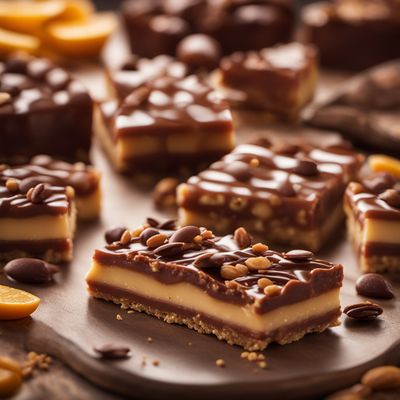
Ingredient
Chocolate substitutes
Decadent Alternatives: Exploring the World of Chocolate Substitutes
Chocolate substitutes come in various forms, such as carob, cocoa powder, cacao nibs, and chocolate-flavored compounds. While they may not possess the exact taste and texture of chocolate, they offer their own distinct characteristics. Carob, for example, has a naturally sweet and nutty flavor, while cocoa powder provides a rich and intense chocolate taste. Cacao nibs offer a crunchy texture and a slightly bitter flavor, and chocolate-flavored compounds mimic the taste and texture of chocolate but are made with alternative ingredients.
Origins and history
The use of chocolate substitutes dates back centuries, with carob being one of the earliest alternatives. Carob, derived from the pods of the carob tree, has been used in Mediterranean and Middle Eastern cuisines for thousands of years. Cocoa powder, made from roasted and ground cacao beans, has a long history in Mesoamerican cultures, where it was used to create a bitter beverage. The development of chocolate-flavored compounds emerged in the 19th century as a response to the growing demand for chocolate products.
Nutritional information
Chocolate substitutes can be a healthier alternative to chocolate, as they often contain less fat and sugar. Carob, for instance, is low in fat and cholesterol and rich in fiber. Cocoa powder is a good source of antioxidants and minerals like iron and magnesium. Cacao nibs are packed with antioxidants and provide a good amount of fiber and healthy fats. Chocolate-flavored compounds may vary in nutritional content depending on the specific ingredients used.
Allergens
Chocolate substitutes may contain allergens such as soy, milk, or nuts, depending on the specific product. It is important to check the ingredient list for potential allergens before consuming.
How to select
When selecting chocolate substitutes, look for high-quality products made from natural ingredients. For carob, choose pods or powder that have a rich brown color and a sweet aroma. Opt for unsweetened cocoa powder made from 100% cacao for a pure and intense chocolate flavor. Cacao nibs should be dark brown in color and have a crisp texture. When choosing chocolate-flavored compounds, read the label to ensure they are made with quality ingredients and do not contain artificial additives.
Storage recommendations
To maintain the freshness and quality of chocolate substitutes, store them in a cool, dry place away from direct sunlight. Carob powder and cocoa powder should be stored in airtight containers to prevent moisture absorption. Cacao nibs can be stored in a sealed container or resealable bag. Chocolate-flavored compounds should be stored according to the manufacturer's instructions.
How to produce
Amateur cooks can produce chocolate substitutes by grinding roasted carob pods into a powder or using a carob powder as a substitute for cocoa powder in recipes. Cocoa powder can be produced by grinding roasted and ground cacao beans. Cacao nibs can be made by crushing roasted cacao beans, and chocolate-flavored compounds can be created by combining alternative ingredients like vegetable fats, sweeteners, and flavorings.
Preparation tips
Chocolate substitutes can be used in a variety of recipes, such as baked goods, desserts, smoothies, and hot beverages. When using carob, adjust the sweetness in recipes as it is naturally sweeter than chocolate. Cocoa powder can be used as a direct substitute for chocolate in recipes, but additional sweeteners may be needed. Cacao nibs can be added to granola, trail mixes, or used as a topping for desserts. Chocolate-flavored compounds can be melted and used in place of chocolate in recipes.
Culinary uses
Chocolate substitutes are commonly used in baking, especially in recipes where a chocolate flavor is desired but with a different twist. Carob can be used in cakes, cookies, and puddings, providing a unique sweetness. Cocoa powder is widely used in brownies, cakes, and hot chocolate. Cacao nibs can be sprinkled on top of ice cream, incorporated into cookies, or used as a crunchy element in desserts. Chocolate-flavored compounds can be used in a variety of recipes, including truffles, ganache, and chocolate coatings.
Availability
Chocolate substitutes are commonly available in grocery stores, health food stores, and online retailers worldwide.
More ingredients from this category

Candies (soft and hard)
Sweet Delights: Exploring Soft and Hard Candies

Sweet bars and other formed sweet masses
Indulgent Delights: Sweet Bars and Confections

Chocolate/cocoa-based products
Decadent Delights: The World of Chocolate

Basic sweet masses
The Art of Sweet Masses

Chocolate and similar
"Decadent Delights: Exploring the World of Chocolate and Its Kin"
Recipes using Chocolate substitutes » Browse all

Caribbean Chocolate Chip Cookie
Tropical Delight Chocolate Chip Cookie

Vegan Chocolate Chip Cookies
Choco-Chip Joy: Vegan Cookies

Moroccan-Inspired Chocolate Chip Cookie Recipe
Spiced Chocolate Chip Cookies with a Moroccan Twist

Vegan Florentines
Deliciously Vegan Florentines: A Plant-Based Twist on a Classic Italian Treat

New Mexican Chocolate Chip Cookie Recipe
Spicy and Sweet Chocolate Chip Cookies with a New Mexican Twist

Classic Chocolate Chip Cookies
Decadent Delights: Irresistible Chocolate Chip Cookies

Vietnamese-Inspired Chocolate Chip Cookie
Bánh Quy Sôcôla Nhân Kem - Vietnamese Chocolate Chip Cookie Delight

New Nordic Chocolate Chip Cookie
Nordic Delight: Dark Chocolate Chip Cookie with Lingonberry Twist

Rocky Mountain Chocolate Babka
Decadent Rocky Mountain Chocolate Babka: A Sweet Treat from the Mountains

Sicilian Cuccia with Almonds and Chocolate
Decadent Sicilian Delight: Almond and Chocolate Cuccia

Decadent Chocolate Fudge Bars
Indulgent Chocolate Heaven Bars

Indo-style Chocolate Chip Cookie
Spiced Chocolate Chip Delight: A Fusion of Indo and American Flavors